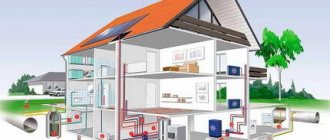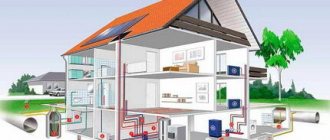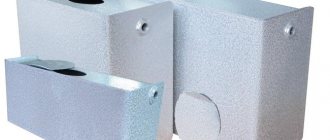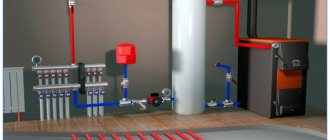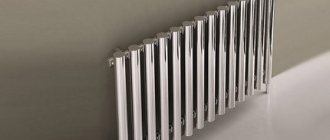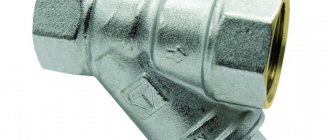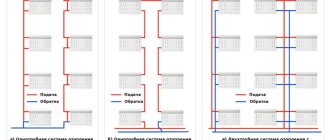The combination of “gas heating” and “wooden house” always receives very close attention. This is all because fire safety has a special place here. Gas heating in a wooden house uses gas, which is explosive. When burned, it also heats the elements of the boiler or convector. That is why, when installing a heating system in a wooden house, fire safety is given such increased attention.
Heating diagram in a wooden house
The installation of gas heating in a wooden house is also due to its characteristics. After all, here the floors are made of boards, plywood or OSB, along joists that lie on beams - and therefore it will not be possible to install a water-heated floor here. The walls of the house are made of logs or timber, so the house is provided with excellent thermal insulation. In this case, the main source of cold will be windows and doors, and therefore the best option would be to place heating devices under the windows.
What is the best way to heat a wooden house?
Each owner tries to equip his premises with the highest quality possible.
Previously, wooden buildings were heated exclusively with a stove. Now you can make heating in a wooden house using a variety of systems. Each device is effective in its own way. Before choosing a particular system, you should study all its pros and cons.
- Types of heating systems Natural circulation or pump
- Gas
Features of heating and its types
Heating installation
One important factor should be taken into account, which directly affects the choice of heating type. The tree, after a short time, loses its natural moisture and, accordingly, dries out. This will entail some consequences, namely settlement of the house. For this reason, the type of heating should be chosen individually in each case. It is first necessary to carry out careful calculations, as well as draw up a project that can facilitate installation work. One mistake in incorrect calculations can lead to the most unexpected and unpleasant consequences, for example, burst pipes or complete defrosting of the system. If the electrical heating calculations are carried out incorrectly, then the matter may end in a short circuit. And if you chose an air system, then it will be impossible to fix anything. The choice of heating type will be directly influenced by the available energy source. Today the following can act as an energy carrier:
- Liquid fuel.
- Electricity.
- Solid fuel.
- Gas.
Article on the topic: How to make a bathroom in a wooden house
Based on this, you can choose the “heart” of the entire heating system of a wooden house - the boiler.
Fire safety rules when installing gas heating
When installing gas heating in a wooden house, there are requirements that must be met. If you ignore them, the likelihood of a fire will increase significantly. It is important to consider the following:
- Between the gas boiler and the wooden wall or floor there must be a shield made of fireproof material - galvanized steel or asbestos. The dimensions of the substrate must exceed the dimensions of the unit on all sides by at least 10 cm.
- All electric and other heating elements are located at a distance of at least 30 cm from the gas boiler. Electrical wiring must not be installed above or below the device.
- The diameter of the chimney must correspond to the boiler pipe. A pipe made of stainless steel should be used.
- The opening for the chimney must be larger than the diameter of the pipe, since it should not touch wooden surfaces. It is necessary to install an additional layer of insulation using asbestos or a piece of cement-asbestos pipe.
- The room where the boiler is located must be well ventilated and have an opening window.
- The mounted unit cannot fit closely to the walls; the gap is 10-20 cm.
When installing a conventional chimney, insulation should be installed at each point where the pipe passes through the ceiling. It is recommended to purchase a ready-made, thermally insulated sandwich-type chimney that meets fire safety standards.
Thus, organizing gas heating in a wooden house is quite possible. It is only important to comply with certain fire safety requirements so as not to put the health and lives of your loved ones at risk.
Main characteristics
This combination - gas and wood - should be given careful attention, because gas has high explosive characteristics, moreover, during the combustion process itself, the parts of the heating structure heat up, which also adds a certain level of risk.
Important elements of the house that need to be taken into account when choosing such heating are:
- Floor material. As a rule, the floor is made of boards, plywood or OSB, which are laid over the foundation beams. Such a base is quite movable, which eliminates the possibility of installing a water-based underfloor heating system, because it must be mounted with a screed.
- Insulation of walls and windows. Basically, such surfaces are made of logs or beams, which have a high level of thermal insulation. The coldest place is considered to be the opening, both window and door. That is why heating of a wooden house should be centralized in such places.
It is also important to note that a large amount of heat is also lost through the roofing areas, so the surface of the floor and attic should also be carefully insulated.
Moreover, a material such as wood has good flexibility, which allows the entire system of pipes and air vents to be installed without much interference.
Heating installation in a wooden house
The first thing to do is to draw up a diagram according to which the amount of material will be calculated and the entire system will be installed. It is very important to draw up a project for the heating system of the entire building in general. The project will include a heating diagram for a specific house, installation of the system, a list of required materials, cost calculations and budgeting.
Article on the topic: How to make a wooden garage door with your own hands
Heating schemes
The most popular scheme is the heating scheme using water. Water heating is based on the circulation of water in a pipe system. The water is heated in the boiler and enters the pipes, from which it enters radiators or other types of heating devices. Heat transfer occurs there. After which the water returns to the boiler.
The type of scheme chosen will depend on how water moves through the pipes naturally or artificially. The diagram can be compiled depending on the number of heating circuits - two-pipe or single-pipe.
If the circulation process occurs naturally, that is, water moves under the influence of its chemical functions (expansion during heating), then the circuit will be one-pipe.
If water moves in the system under the influence of a pump (artificially), then the system may already have a two-pipe circuit.
When using a single-pipe system, it is difficult to regulate the temperature throughout the house. It will be different. The further the radiator is from the source, the lower its temperature. The two-pipe system makes it possible to avoid this.
Installation of a single-pipe heating system
Fig No. 1 Diagram of a single-pipe system
Let us present, as an example, two installation schemes for a single-pipe heating system for two-story wooden houses. Using them, you can simply install such a system with your own hands.
The disadvantage of installing such a system is that the lower radiators will heat up a little less. And a wooden house will have different temperatures on different floors. But if you follow the exact diagram, it is easy to install it yourself. And another advantage of this installation is the small amount of materials involved in the design. And to equalize the temperature, you just need to increase the number of sections on the radiators installed at the end of the system. For faster circulation, a circulation pump can be installed at the cold water inlet.
Article on the topic: What to make the base of a wooden house from
Fig No. 2 Diagram of a single-pipe system
It is worth noting that schemes with natural circulation are possible if it is possible to install the boiler below the installation level of the radiators. Otherwise, water simply will not circulate in the pipes. During installation, it is necessary to observe the natural angle of inclination from hot water towards the radiators and back, from cooled radiators to the boiler. The expansion tank must be installed in such a circuit. When installing a pump in such a system, its efficiency increases significantly and makes it possible to install the boiler at any level. If the boiler already has a pump in its configuration, then the question of installing separate equipment is no longer raised.
The system presented in Figure 2 (horizontal arrangement of pairs of radiators) involves the use of such a pump. To maintain uniform temperature throughout the entire system.
The difference between the two schemes lies in the junction with a shut-off valve.
Installation of a two-pipe heating system
Fig No. 3 Diagram of a two-pipe system
Figures 3 and 4 show diagrams of two-pipe heating systems. Figure 3 shows a diagram with natural circulation of water in the upper circuit. In this case, the radiators have the same heating temperature. But the material costs for such a system are higher than for a single-pipe system. Shut-off valves are used for each radiator in such a system, which will allow you to control the temperature in each of them separately.
In Figure 4 we see exactly the same system as in Figure 3. But with lower wiring.
Fig No. 4 Diagram of a two-pipe system
This is a good option for those who plan to install a boiler in the basement, and the pipes are additional sources of heat. This scheme is more popular for do-it-yourself gas heating of two-story wooden houses. Wooden houses are distinguished by the fact that radiators can be attached to the walls directly or by first nailing two bars.
These schemes are also suitable for boilers with hard fuel. The only thing that needs to be changed is the material of the pipes.
Article on the topic: How to properly insulate the floor in a wooden house with polystyrene foam
Electric heating
If there is no gas access, then electricity can be used.
There are many options for a wooden house. This is a “warm floors” system, which is sold ready-made or made independently.
It is not very convenient for houses with wooden floors (see flooring) because its installation requires a concrete screed. But if you make a heated floor from a water electric boiler, then this is a completely realistic project.
Such a system has its advantages. This is silent operation, accuracy of the temperature in the room.
Metal-plastic pipes with a diameter of 16–20 cm are taken. They are laid on a heat-insulating layer. The laying pattern is usually spiral, as shown in the diagram, or combined. From the base of the collector pipe, which is connected to the boiler, you can see 10 cm from the walls. The second circuit has a distance of 40 cm from the first. This is done in order to later place the return pipe here. So the laying step will be 20 cm.
The pipes need to be fastened to each other on a straight section every 1 m, and more often on bends.
After fastening, the reliability of the system is checked. Simply put, they fill the pipes with water and see if there are any leaks. Then a second wooden formwork is made in the wooden house and the floor is laid on top.
The peculiarity of such a system in a wooden house is that the pipes are formed between two formworks, lower and upper. Thermal insulation prevents heat from escaping downwards and, rising upward, it warms the floor and the room.
Heating using solid fuel
Such a system can be used in homes where there is no access to electricity or gas.
Today, solid fuel boilers still exist. Their installation is difficult and requires the skills of not only a heating engineer, but also a welder. The design of such systems, in principle, is not much different from a single-line natural circulation heating scheme. Only the pipes will come either from the furnace or from the boiler with hard fuel. Article on the topic: Is it possible to attach a fence made of corrugated sheets to wooden logs?
If the boiler has a more modern configuration, then the installation of such a system is the same as in Figures 1 and 2
When installing this type of heating, you need to use metal pipes.
Choosing a boiler
If the source is gas, then it is best to choose an automatic wall-mounted gas boiler. This generator is equipped with a pump and protection. If a chimney is not provided, then you need to opt for a boiler with a closed combustion chamber. And to exhaust air in such a boiler, you can use a coaxial pipe. This will save money on pipe installation.
Wall-mounted boilers already have full automation, but if the water volume is more than 100 liters, install an additional expansion tank, even if there is a built-in one. It will make it possible to compensate for the expansion of water when heated. Otherwise, the pressure in the boiler will increase greatly as the temperature rises, and the automation will often turn off.
If the choice fell on an electric boiler, then it is best to choose a fully automatic boiler, with a built-in pump and expansion tank. This option will be more convenient to install and will avoid many mistakes.
Be sure to use a special device to stabilize electricity for such a boiler.
If the fuel is of a hard nature, then such a boiler can be installed by yourself, only if you know how to weld. And they are able to weld heating pipes with their own hands. The outlet temperature of this type of boiler can reach 100 degrees and it will be difficult to install any pipes other than iron ones without the help of professionals.
You can also use plastic pipes in a system with a boiler powered by hard fuel, but a special decoupling is required. Only highly professional heating engineers can carry it out.
When the boiler is selected, you need to select the right pipes and radiators. Various materials are used for pipes today. But when installing it yourself, it is best to use plastic. It is easy to install. The quality of metal pipes today has deteriorated greatly. So from the proposed option, choose metal-plastic or polypropylene.
The material has been selected, all that remains is to draw a diagram and choose a project for your home. The project will depend on the type of heating you choose.
Radiators are chosen depending on what kind of heat transfer you want to get and which ones suit your interior. The larger the radiator sections, the warmer the house will be. The calculation is 1 section per 1.5 square meters.
The appearance of radiators should not spoil the overall appearance. You will make the right choice by watching the video:
Calculation of materials is carried out after drawing up a detailed diagram of the heating system of your home.
For a wooden house, radiators with a bottom entry are usually used. This is due to the fact that it is difficult to hide pipes in the wall of such a house. They are hidden under the floors between floors.
Heating system design options
Gas heating of a wooden house with your own hands can be done in accordance with two schemes:
- The first option is the use of traditional double- or single-circuit boilers. The advantage of using such units is their autonomy of operation. For example, many foreign-made models are used on a “set it and forget it” basis.
Economical, easy-to-use wall-mounted boiler
Such a device, being equipped with a thermostat, independently maintains the specified temperature parameters. In addition, if you are away for a long time, the boiler will automatically circulate water through the system once a day so that it does not stagnate.
The photo shows domestic products of the Junker brand
A significant advantage of Western European boilers is their efficiency. The fact is that this equipment was initially designed for countries where the cost of natural gas is high. Therefore, such installations are an order of magnitude more economical and more powerful than domestic designs.
The boilers are ergonomic, regardless of whether you purchased a floor-standing or wall-mounted model. And finally, such installations are fireproof.
Among the disadvantages, it should be noted the need to draw up and approve a heating system project. In addition, the price of truly high-quality imported equipment is high.
- The second option is to use a gas convector. This solution is the best option if there is no prospect of connecting to the main line, and gas is sold only in cylinders.
Convector with removed protective casing
The disadvantage of convectors is the ability to heat a limited space. Therefore, if the construction project is multi-room, you will have to invest money in the purchase of several devices, and accordingly the price of the heating system will be high.
Gas convector operation diagram
Another disadvantage of converters is their limited functionality. For example, if a boiler heats a room and heats water for consumer needs, then a convector only heats it.
Article on the topic: Why do you dream about an abandoned wooden house?
Chimney installation in a wooden building
The instructions for exhaust gas removal are largely determined by the type of heating equipment:
- When purchasing a modern gas boiler with a closed combustion chamber, you can count on the installation being equipped with forced exhaust. This hood is a neat compact pipe with a diameter of no more than 100 mm.
An axial fan is built into the pipe, consuming no more than 100 W. By installing the exhaust pipe into the hole made in the wall, the gap at the edges of the chimney is filled with foam.
- The installation instructions for boilers with an open combustion chamber are different. In this case, you will have to build a full-fledged chimney that will pass through the roof.
Natural exhaust project
The main requirements for such chimneys are the absence of direct contact with wooden structures. In addition, the exhaust gas removal device should not have more than three bends.
Of course, when constructing a chimney and when connecting it to heating equipment, it is necessary to ensure absolute tightness in order to exclude the possibility of carbon monoxide entering the room.
Important: In order to comply with fire safety regulations, it is advisable to purchase a ready-made thermally insulated chimney.
Sandwich systems have a layer of thermal insulation located between two metal shells. Therefore, during installation, such structures can be leaned directly against the elements of the rafter system or against other wooden structures.
Location of heating equipment
The instructions for the location of heating equipment are largely determined by its design and operational features.
Let's consider where and how to mount gas-fired heating units:
- From the point of view of air exchange efficiency, it is advisable to place convectors directly under the window opening . The front edge of the device should protrude slightly forward beyond the line of the window sill.
Of course, for safety reasons, it is not recommended to use fabric curtains on the window opening. You can limit yourself to installing plastic or metal blinds directly in the window opening.
- Mounted heating boilers with a closed combustion chamber and forced exhaust can be installed almost anywhere where it is convenient to connect all the necessary communications . For the installation of floor-standing boilers, it is advisable to allocate a special room.
Important: Both types of heating equipment are installed and operated in accordance with a specially developed and approved project.
- Heating boilers with an open combustion chamber are installed exclusively in specially designated rooms with a specially equipped exhaust gas removal system and ventilation arranged in accordance with the design documentation . Just like the previous categories of heating equipment, boilers with an open combustion chamber require a specially developed and approved project.
Article on the topic: How to make a bath in an old wooden house
Types of gas convectors and their advantages
Heaters differ from each other only in the presence or absence of a fan blowing the combustion chamber and in design.
Gas heaters vary greatly in terms of power. This factor is influenced by the volume of the heated room.
Gas convector installation diagram.
Many sellers of convectors often make arguments in favor of their own product, claiming that it is compact. In this case, doubts immediately arise, since the convector looks more like a large fireplace than a miniature heating device.
Another indicator is the relatively low cost of production, which, of course, can also be argued with. After all, this price is much higher for a standard convector used for a conventional heating complex.
Among the real and worthy advantages of a gas convector, it is worth highlighting the absence of water as a coolant in the heating complex. This represents a great level of convenience in winter, when there is no need to worry about water freezing in the pipes (this is beneficial for summer residents). However, such changes in temperature have a detrimental effect on the interior decoration of the house; there is a risk of dampness and frost, which can damage the furniture. Accordingly, it is better not to use convectors in houses for permanent residence (even summer cottages). Such devices are more useful in non-residential premises (sheds, workshops, garages).
In terms of environmental friendliness, some questions may also arise. A plus is that the convector does not absorb oxygen. The temperature of the heating device (boiler or convector) should not go beyond 60 degrees. Otherwise, the process of dust decomposition will begin, and you will have to forget about environmental friendliness
However, can a gas convector maintain such a fairly low temperature? If the convector performs a similar function, then this is quite important, otherwise it is also better to use it in non-residential premises
Advice from professionals
Proper operation of gas equipment is not only reliable and durable, but also, above all, the safety of everyone living in a private wooden house. According to existing legislation, the user is responsible for the safe operation of boilers.
Therefore, experts advise boiler owners to adhere to a number of simple rules:
- Carry out periodic maintenance of the unit within the time frame and in the amounts established by the equipment manufacturer, as a rule, at least once a year.
- There is no need to save money on filters. Both the gas pipeline and the heating circuit must be provided with similar protective devices.
- It is unacceptable to use rubber hoses to connect gas.
- During the operation of the boiler, the quality of combustion, draft in the furnace and ventilation in the furnace room are monitored.
If there were previously doubts about installing gas boilers in houses made of timber, then they are a thing of the past. Innovative gas heating today is most suitable for such a facility, since it has reliable automatic protection and a thermal process control system.
All this allows you to completely prevent the creation of emergency and fire hazardous situations in the house.
Installation of a chimney in a wooden house
If you have already decided to make gas heating at home with your own hands or with the help of specialists, then you need to know that according to fire and gas safety requirements, the boiler room must have a chimney and an exhaust hood.
If you have a gas boiler with an open combustion chamber, then the chimney must be vertical and large-sized. If the boiler has a closed combustion chamber, then a bulky chimney is not needed. A boiler of this type uses forced draft, so a pipe with a diameter of 10 cm will be needed to remove combustion products. The hole for this pipe must be lined with non-flammable material. The air for the burner will come from outside, so there will be no need for constant ventilation of the room (as with a boiler with an open combustion chamber).
Article on the topic: Why does a wooden house cool down quickly?
Since the house is wooden, there is no way to create channels inside the walls. Therefore, an insulated metal chimney (“sandwich”) is very often used. The hood is also made from this type of pipe. Often these channels lead directly to the street, and rise up along the outer wall. This works effectively, but there are a few problems.
If there are severe frosts in your area, then the chimney insulation may not cope with its task. So, the air inside the pipe cools down and then falls down, thus plugging the chimney and hood, or even creating a draft in the opposite direction. This leads to the fact that the gas water heater for heating the house stops in emergency mode or the boiler room gets cold. Therefore, if you use sandwich type pipes, then place them in the part of the building that is heated, and only a small part will be discharged to the roof.
A good option is built-in or attached brick chimneys. If you decide to use just such a chimney, remember that the walls inside must be plastered.
Chimney device
According to fire safety rules and in accordance with the requirements of gas services, the boiler room must have a chimney and an exhaust hood; this must be taken into account when installing gas heating in a wooden house.
A large vertical chimney is necessary when installing a boiler with an open combustion chamber. A small chimney is sufficient if the combustion chamber of the gas boiler is closed. Such boilers provide for the creation of forced draft, which means that a pipe with a diameter of 10 cm will be sufficient to remove combustion products. The hole prepared for it must be paved with fireproof material. There is no need for constant ventilation, since the air needed for the burner comes from the street, which cannot be said about boilers with an open chamber. For them, the room must be constantly ventilated.
Article on the topic: Why does a wooden house cool down quickly?
When heating a wooden house, a so-called chimney is used - a “sandwich” (insulated metal pipe). The hood is made from it. Since the channels cannot be installed inside wooden walls, they are taken outside and raised up the wall from the outside.
Despite the great effectiveness of the method, problems also arise. When severe frost sets in, the thermal insulation of the pipe may not be so reliable. As a result of cooling, the air inside the “sandwich” descends into the chimney and hood, a kind of plug is formed, causing the draft to appear in the opposite direction or disappear completely. The combustion in the gas water heater stops, the boiler room cools down, and the house stops heating.
Chimney arrangement diagram
Despite the presence of thermal insulation, insulated pipes should be installed in the heated part of the house, and a smaller part of them should be brought to the roof.
Chimneys can also be made of brick (built-in or attached). When installing such chimneys, it is necessary to plaster the internal walls of the structure.
Two-pipe
For proper installation of a heating system with two-pipe wiring, two circuits should be installed: a pipe for supplying coolant to the radiators and returning it back for heating. To connect the radiators themselves, a parallel version is used. Due to this, it is possible to locate the lower pipeline layout, as well as independently adjust each component. If at the same time one of them is brought to the ideal, this will not in any way affect the performance of all the others.
These heating distribution options reduce the existing disadvantages of a single-pipe system, having reduced energy consumption and a higher degree of heat transfer. The entire area of the room will warm up evenly without temperature fluctuations.
Additionally, air vents are installed on radiators, as well as a shut-off valve at the point where the hot medium is supplied. This allows you to control the temperature of each battery in the room and individually. There is no need to install shut-off valves on the return line.
This type of wiring cannot do without disadvantages, which manifest themselves in the consumption of materials during the installation of the heating system. After all, you will have to purchase double the number of pipes compared to the single-pipe option.
Installation of heating systems
In order to save money, the installation of a heating system can be done with your own hands. In this case, it is very important to take into account all the norms, rules, follow the sequence of actions, as well as fire safety precautions.
Electrical system design
Installing a system for heating a house using electricity is considered accessible even to those who have no practical experience. Connection of convectors, selected according to the power according to the square footage of the room, occurs using a regular socket. If there are several devices, each of them must have a separate circuit breaker installed in the electrical panel and an individual grounded power source.
Electric boilers are installed in a place convenient for pipe distribution in the house; in addition, radiators made of bimetal, aluminum or steel are installed in the rooms and pipes with fittings are installed.
It is advisable to make the coolant circulation system forced by installing an additional circulation pump. This will allow you to get significant savings. A multi-tariff meter can also help minimize costs.
Article on the topic: How to make a bath in an old wooden house
Electric heating systems also include “warm floors”. They are installed under the floor surface or in a concrete screed. It is important to ensure good thermal insulation of the base under the floor, which will not allow heat to dissipate.
Gas heating
This type of heating can be carried out by installing a gas boiler (used if there is a gas main nearby) or a convector (advisable if the gas is imported). Boilers with electronic ignition are considered the most economical.
If the system operates from a centralized boiler, the coolant will circulate through pipes and radiators, which provide heat in the room. At the same time, in addition to installing the pipeline, it is important to equip the boiler room and install a high-quality ventilation system there.
If a scheme with convection heating is chosen, then it is necessary to install pipes around the perimeter of the house, and the radiators should cut into them in parallel, and not breaking the system.
Convectors are placed in each room of the house under the window, a gas cylinder is placed nearby, and a coaxial pipe ensures the removal of combustion products.
Solid and liquid fuel boilers
This type of heating is most often used in areas where other heating methods are not available. The boiler must be installed in a specially designated room or on the ground floor. If you plan to install the system yourself, then it is worth considering some points:
- Mandatory installation of a compensation system.
- Use of high quality materials (radiators and pipes).
- The importance of correct connections and joining of elements, preventing leakage.
- Reducing the number of risers (installation of wiring on all floors).
Important: do not attach the solid fuel boiler piping to a wooden wall!
The main thing is to do everything correctly when installing a heating system in a wooden house: strictly follow the instructions and adhere to safety requirements.
Subtleties of radiator selection
Radiators are one of the most important components of the system. After all, they distribute heat throughout the living space. Therefore, their choice should be taken with full responsibility, and not buy the first product you come across.
Batteries are divided into categories depending on their design and the material from which they are made. Since a wide assortment can drive an unprepared buyer into a dead end, before going to the store it is necessary to understand the advantages and disadvantages of each type.
Aesthetics of aluminum structures
Such products appeared in Italy more than 35 years ago. Since their invention, aluminum heating radiators immediately became popular and won the recognition of professionals.
When choosing a heating radiator, first of all you should familiarize yourself with the material of the sections. The heat transfer of the battery, its service life and weight depend on it
And this is not at all surprising, because these structures are distinguished by their lightness, high heat transfer, and attractive design. But they are poorly resistant to corrosion and are susceptible to airing.
Aluminum batteries can be cast or extruded. The first type is a monolithic structure, and the second is a blank formed by a press, from which finished products are subsequently cut.
Cast structures are considered more reliable and durable. In other respects, their analogues are in no way inferior to them.
Aluminum batteries are relatively lightweight. This makes them easy to transport and connect, something you can do yourself
Panel steel radiators
Steel is an excellent heat conductor. Therefore, batteries made from it are considered the most effective and are recommended for installation by all specialists. In addition, they are a monolithic structure, which greatly simplifies installation.
Provided that steel radiators are used in a house or country house with an autonomous heating system, they have no disadvantages. If all recommendations are followed, the service life can reach 30 years.
Batteries of this type are often supplemented with heat exchangers. But this in no way affects the appearance of the structure.
Good old cast iron
Cast iron radiators were first used more than a century ago. But even today they have not lost their relevance and are actively installed in heating systems.
The reason for this is its ease of maintenance and simply enormous service life - cast iron will faithfully last for about 50 years. At the same time, it retains heat well. The products take a long time to heat up, but after turning off the heating they will heat the room for a long time.
Taking into account all their advantages, cast iron appliances have only one insignificant disadvantage - they are heavy. Thus, the weight of one section can reach 6 kg, and the weight of the entire battery can be 36 kg.
Even in comparison with bimetallic and aluminum products, cast iron structures are a good and universal solution with many advantages
Tubular radiators made of steel
Tubular batteries, as a rule, are classified as products in the highest price segment. They fully comply with all quality standards and have a number of advantages over their analogues.
First of all, such structures can easily withstand sudden changes in pressure, and in the event of a heat cut, the battery will not become air-filled.
Also, tubular radiators have a smooth surface both outside and inside. Thanks to this, they have an attractive appearance, due to which they will harmoniously fit into any interior.
Tubular steel radiators are an expensive proposition. But at the same time, they last for about a quarter of a century, which completely pays for the costs.
Modern bimetallic structures
These types of batteries are made from an alloy of aluminum and steel. These metals have completely different characteristics, and as a result of their combination, a material with excellent performance is obtained.
More precisely, these radiators show high thermal conductivity and can easily withstand water hammer. If assembled with high quality, bimetallic products last about 50 years. But they are quite expensive.
Even despite the high price, it is better to spend money once and buy a bimetallic radiator from a reliable supplier. Thanks to its long service life, it will fully justify the investment.
Built-in floor convectors
This heating device is a tube made of copper and aluminum through which the coolant moves. The main advantage of floor convectors is the ability to build them directly into the floor.
In this case, the structure does not take up precious residential square meters, but at the same time warms the building well. The only thing that comes out is the decorative grille or panel.
If installation is carried out incorrectly, drafts may form inside the room. In addition, you need to carefully monitor the cleanliness of the heating element - air flows carry dust well.
It is better to choose a floor convector made of copper, steel or aluminum. In this case, the structure will last a long time, and the house will warm up almost instantly
